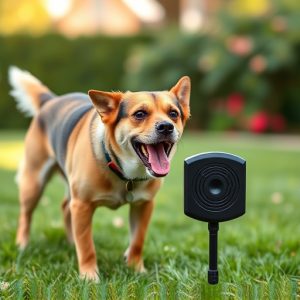Electronic Pet Behavior Correction Tools: Mounting Options & Training Tips
Electronic pet behavior correction tools, including remote trainers and static collars, offer a mode…….
Electronic pet behavior correction tools, including remote trainers and static collars, offer a modern approach to train dogs by combining auditory and electrical stimuli. These devices come with various mounting options like collar-mounted units, remote controllers, and GPS tracking models, allowing owners to customize intensity and frequency based on their pet's needs. For effective use, select devices designed for animals, adjust settings accordingly, demonstrate desired behaviors, introduce the tool gradually, combine it with positive reinforcement, and choose convenient mounting options like collar clips for easy access during training.
“Unleash a happier, better-behaved pet with an electronic behavior correction tool—a modern solution for dog training. This comprehensive guide explores these innovative devices and their role in shaping canine conduct. We’ll delve into the science behind them, from understanding various types to optimizing Mounting Options for Electronic Dog Deterrents. Learn essential safety precautions and training techniques to ensure effective, humane conditioning. By the end, you’ll be equipped to navigate this technology’s potential.”
- Understanding Electronic Pet Behavior Correction Tools
- Types of Electronic Dog Deterrents and Their Functionality
- Mounting Options: Where to Place the Device
- Safety Precautions and Training Tips for Effective Use
Understanding Electronic Pet Behavior Correction Tools
Electronic pet behavior correction tools, also known as remote trainers or static collars, are innovative devices designed to help train and correct unwanted behaviors in pets, particularly dogs. These tools use a combination of auditory and electrical stimuli to communicate with animals, offering an alternative approach to traditional punishment-based training methods. Understanding how these devices work is crucial for responsible pet ownership.
These correction tools come with various mounting options for electronic dog deterrents, such as collar-mounted devices that deliver gentle pulses or beeps when a specific behavior is exhibited. The goal is not to cause discomfort but rather to give a subtle signal to the dog, helping them learn what actions are unacceptable. Different models offer adjustable settings, allowing owners to customize the intensity and frequency of the stimuli based on their pet’s sensitivity and learning curve. This ensures a tailored training experience that considers individual dog preferences.
Types of Electronic Dog Deterrents and Their Functionality
Electronic dog deterrents, also known as remote training aids, come in various forms and offer innovative ways to modify pet behavior. These tools utilize different technologies to provide a gentle correction or stimulus when a dog exhibits unwanted actions, such as barking excessively or jumping on people. One common type employs a collar with a small transmitter that emits a high-frequency sound or mild static shock upon detection of specific behaviors. This method is effective for addressing issues like excessive barking and can be adjusted to suit different sensitivity levels.
The mounting options for electronic dog deterrents are diverse, catering to various user preferences and training styles. Some models feature remote controllers that allow trainers to activate the device from a distance, providing flexibility in handling and managing the dog’s behavior. Others integrate GPS tracking capabilities, enabling real-time monitoring and precise control during outdoor walks or runs. Additionally, there are collar-mounted devices with adjustable settings, offering a customizable approach to training, and ensuring comfort for the pet while effectively correcting unwanted behaviors.
Mounting Options: Where to Place the Device
When considering mounting options for an electronic dog deterrent, location is key. The device should be placed in a strategic spot that allows it to effectively monitor and correct unwanted behaviors. Common locations include doors, windows, fences, or walls – areas where dogs are likely to approach or bite. Ensure the chosen spot is easily accessible for adjustments and maintenance, while also offering line-of-sight visibility across the desired area.
Consider the behavior you want to correct when selecting a mounting location. For example, if the tool is intended to deter barking, placing it near a window where barking often occurs can be ideal. Similarly, if targeting jumping or nipping, securing the device at door entrances can help train dogs to avoid these actions. Versatile mounting options that allow for easy repositioning can also benefit users looking to adapt their training strategies over time.
Safety Precautions and Training Tips for Effective Use
When using an electronic pet behavior correction tool, safety is paramount. Always ensure the device is designed for pets and follows regulations to prevent any harm or discomfort. Choose products with adjustable settings to tailor responses according to your pet’s sensitivity level, and never use it as a substitute for training. Regularly inspect the device for any damage, especially after outdoor use, and keep it charged for optimal performance.
Training is key to the effective use of these tools. Start by demonstrating desired behaviors without using the correction feature, then introduce the device gradually, rewarding good behavior. Be consistent with commands and timing; the tool should emit a brief, sharp signal when your pet exhibits unwanted behavior. Never leave the device on constantly, as it could cause fear or aggression. Instead, use it sparingly and in conjunction with positive reinforcement to reinforce learning and promote a happy, healthy relationship with your pet. Consider mounting options like collar or harness clips for easy access during walks or training sessions, ensuring convenience and control.
Electronic pet behavior correction tools offer a modern approach to training, providing safe and effective solutions for unwanted behaviors. By understanding different types and their functionality, along with optimal mounting options like strategic placement on doors or fences (Mounting Options for Electronic Dog Deterrent), responsible owners can use these devices as part of a positive reinforcement strategy. Always prioritize safety precautions and follow expert training tips to ensure successful and humane behavior modification for your furry friend.


